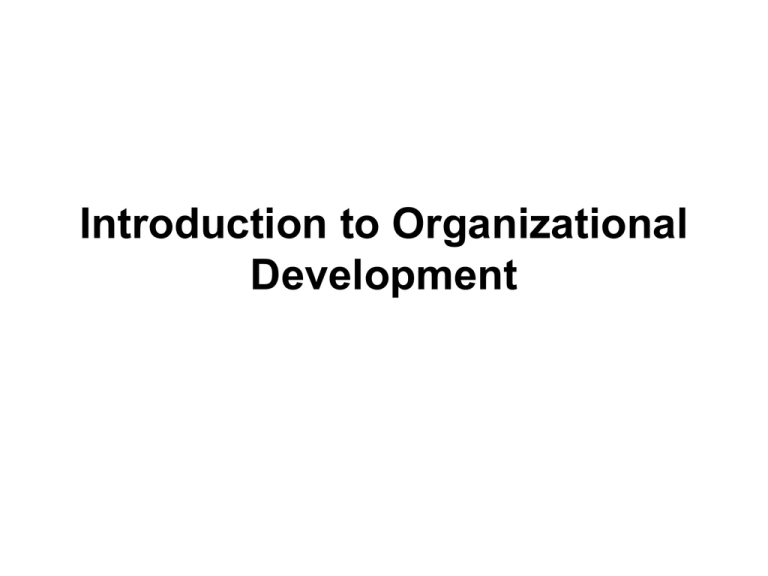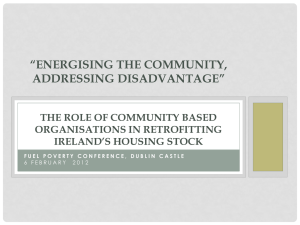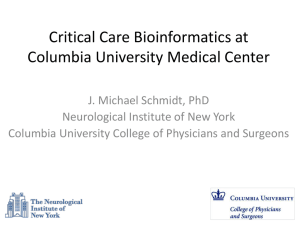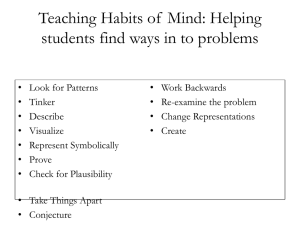DRAFT SB for Intro to Org Development 2_05_13 JH
advertisement

Introduction to Organizational Development Organization Development – Intro and Objectives This course introduces organizational development to professionals in the relief and development sector. After completing this course you will be able to: Explain Organizational Development (OD) and why it is important Identify the six pillars of OD (illustrative elements of each pillar and how they interrelate) Describe the five step process for OD (Define, Assess, Visualize, Plan, Implement) Implement tools to help you in applying OD in your work 2 Organization Development – WIIFM Before we start, let’s hear from some organizations about the importance of OD from their perspectives … Foundation Local NGO 3 International NGO Organization Development – Definition Mike to provide 4 Organization Development vs. Technical Capacity Need to write this – reference below 5 The Six Functional Areas of OD Program Design, Management, and Quality Control Financial Management Governance & Strategic Management Financial Sustainability External Relations Human and Material Resources There are six functional areas of organizational development. A strong sustainable organization will be robust in each of these areas. All of these are important elements. .. As an org develops capacity in each of these areas, it is important to recognize the interconnectnesss of these six components, Investments in one area impact performance in other components areas. For example, strong human resources will have a positive impact on governance and strategic management, and strong external relations have an impact on financial sustainabilty. Click on earn more about examples of.thekinds of investments in these areas that can make an organization strong. 6 The Six Functional Areas of OD: Program Design, Management, and Quality Control A strong organization will have made investments in Program Design, Management. and Quality Control, such as the following examples: Organziations with strong Program Desig, Management and Quality Control might have the following systems in place: Indicators/Components of a strong functional PSMQC area, might be: Examples of Client driven performance monitoring and evaluation systems for all programming. Needs assessments and marketing assessments to measure the effectiveness of services as well as to identify potential new services to be delivered. Program management systems in place ensure high demand-driven, impact-based services are provided as efficiently and effectively as possible. 7 The Six Functional Areas of OD: Financial Management The category of Financial Management includes the following activities: Organizations manage revenue. Organizations plan, document and analyze fund usage. Organizations identify potential for additional resources. CSOs track the flow of finances in line with local laws and regulations as well as donor requirements These systems are critical. Developing and practicing transparent cash management, accounting, and financial management systems with sufficient checks and balances and different levels of authority helps organizations minimize fraud, theft and / or corruption and increase cost efficiency and effectiveness. 8 The Six Functional Areas of OD: Governance & Strategic Management The category of Governance & Strategic Management includes the following activities: A clearly defined mission, vision, and strategic objectives. A planning process that involves them in a continuous cycle of needs assessment, staff development, business planning, and evaluation of progress toward goals and deadlines. Defined roles and regulations for the governing body and the relationship between that body and program management to ensure democratic and transparent management. 9 The Six Functional Areas of OD: Financial Sustainability The category of Financial Sustainability includes the following activities: Comprehensive, long-term sustainability planning, A plan for financial diversification; Asset based (rather than donor based) fundraising strategies: donor requirements , corporate or state partnership, membership development, fee for service / social entrepreneurship traditional fundraising 10 The Six Functional Areas of OD: External Relations The category of External Relations includes the following activities: A list of key stakeholders, including clients, media, government, business, community members and leaders, and other CSOs and communicate with them regularly and effectively. Aninternal management process that allows staff and volunteers to freely share information and communicate in a way that is clear, consistent, timely, and accurate. 11 The Six Functional Areas of OD: Human and Material Resources The category of Human and Material Resources includes the following activities: Organizations hire appropriate staff and staff competency are a result of formalized human resources policies and procedures, staff development and training plans, and the use of volunteers and consultants to supplement staff skills and outreach. Human resources emphasize local employment laws and regulations, the role of a leader, understanding office politics, participatory management, and time management. Organization also has the physical resource base to adequately provide products and services (i.e. fulfilling its mission) and these resources are procured and maintained to ensure greatest cost efficiency as possible. 12 The Five Steps of OD The process of OD involves five key steps, or phases: 1. Define 2. Assess 3. Visualize 4. Plan 5. Implement 13 The Five Steps of OD Step 1: Define 1. Define In the define phase, you definite what OD means to your organziation … what __ Cofnirm that the six compoent framework meets your needs? We identfied a six compoent model, before sttartig the process, confirm that this structure meets your needs. Is something missing? Is there an additional component that needs to be added? 1. 2. 3. 4. 5. 6. Product and service management and quality control Financial management Governance & Strategic management Financial Sustainability External Relations Human and Material Resources 14 The Five Steps of OD Step 2: Assess 2. Assess In the assess phase, you assess your current state – the state that your organization is currently in now. There are two approaches to assessing your current state: Formal approach – using self-assessment survey tools (quantitative) Informal approach – through discussion.(qualitative) Let’s take a closer look at each approach, and learn about the tools available to help you in your assessment of your current stage. 15 The Five Steps of OD Step 2: Assess – Self-Assessment Tools 2. Assess In the assess phase, you assess your current state – the state that your organization is currently in now. There are two approaches to assessing your current state: Formal approach – using self-assessment survey tools Informal approach – through discussion. Let’s take a closer look at each approach, and learn about the tools available to help you in your assessment of your current stage. 16 The Five Steps of OD Step 2: Assess – Self-Assessment Tools 2. Assess To help assess which fits better – choose the rfight tool for the right situation Formal approach – using self-assessment survey tools SEE REFEREENCE FOR THE DISCUSSION Informal approach – through discussion. 17 The Five Steps of OD Step 2: Assess – Discussion 2. Assess Here are some ideas for how you can assess your current state through discussion. It involves facilitating an activity in which you work with members of your organization to identify main themes and capabilities from stories. Ask members of your organization to think about and then share a story or powerful ideas about the work of your organization. As the story-telling proceeds, you will assist the group members in extracting common themes of positive experience from the stories, and listing these on a flipchart. These will be themes related to what works in the organization and what gives it life and meaning. (Example: Many members share stories about the positive response they have received from the community in carrying out their work. You may wish to list ‘community response’ as a positive theme for the CBO.) 18 The Five Steps of OD Step 2: Assess – Discussion 2. Assess As the themes are identified and extracted from the discussion, you should draw visual representations of each topic on a large circle. For example, if the topic / theme is ‘Leadership’ you may draw a group of people with 2 or 3 leaders standing in the front. For ‘Volunteerism’ you may draw the group with their hands in the air, showing their willingness to volunteer. You will need to use your imagination and creativity for this! You may also ask the CBO members to try to come up with the drawings themselves. 19 The Five Steps of OD Step 2: Assess – Discussion 2. Assess This will probably be a messy process and you as a facilitator will need to be listening carefully and helping the group to extract the themes. It is not likely that the groups will talk about themes using the exact words that you want to hear. They may not use the words ‘Financial Sustainabilty’, or ‘Volunteerism’, for example, but as you are listening to their stories you should be trying to extract these ideas from what the group is saying.. Here is an example: CBO Member: I remember the time when we wanted to organize a recreational activity for the children in the community. We all got together and decided what we needed to do. We purchased a football and Luisa and Telma brought jump ropes. About 40 boys participated in the football match and even more girls were jumping rope all afternoon. It was one of the best events that our CBO carried out. From this example it sounds like your CBO is very good at planning. Facilitator: 20 The Five Steps of OD Step 2: Assess – Survey based Tools 2. Assess You can also use a survey based tool to help you asses your current state. The self assessment tool from counterpart International walks you through each of the functional areas (the OD pillars) and asks you to rate your organization according to questions in those areas. As an example let’s take a look at some of the questions in the area of Leadership and Strategic Management. 21 The Five Steps of OD Step 2: Assess – Survey based Tools For each of these items, you will score your organization using the following rating scale: Don’t know – 0; Strongly disagree – 1; Disagree – 2; Agree – 3; Strongly agree – 4; Not applicable – NA You can use the comments box on the right to add any comments. 22 The Five Steps of OD Step 3: Visualize 3. Visualize . It is critical to visualize for the future to help you in capacity building. Two key questions that often will help you in discovering the importance of capacity building are as follows: 1. If your Executive Director was no longer there starting tomorrow, would you be in a position to keep moving forward? 2. If you received a donation of a million dollars tomorrow, would you be ready to effectively place those funds into programs? 23 The Five Steps of OD Step 3: Visualize 3. Visualize . Exercise: Identifying Capacity Areas by Raising the Issue of Money Here is an exercise that you can use to help members identifying organization capacity areas for improvement and visualize for the future. Before starting, it is important to note that you must use this exercise very carefully, for the following reason: Sometimes talking about money and fund-raising will help the group to think about the organizational capacities that they need to improve, and so it may be a useful discussion to have. On the other hand, it can raise false expectations whereby the CBO begins to think that funds are forthcoming from you, your organization, or other external sources. It can also serve to minimize the importance of everything that the CBO is already managing to do for community target groups without money. You may choose to have this conversation with the group but you must be sensitive to these issues, explaining very carefully that the conversation does not imply that funds are forthcoming, nor does it imply that the only good work that the CBO can do is that work they do using these funds. Let’s get started … 24 The Five Steps of OD Step 3: Visualize 3. Visualize . Exercise: Identifying Capacity Areas by Raising the Issue of Money Sometimes a group will be most successful in identifying organizational capacity areas for improvement if you ask the following question: ‘Imagine that your CBO wants to compete for funding from the District Department of Social Welfare to expand your activities. In order to compete for funds like this, what sorts of things do you think the funder will require, or will want to see in your organization?” We will use a visual of a tree and white circles to represent capacity areas for this exercise. 25 The Five Steps of OD Step 3: Visualize 3. Visualize . 1. Ask the question to the group and help them to think of the possible answers. Examples might include: • Budget • A record of what we are doing (Monitoring) • Etc. 2. As you and the group come up with these new capacity areas, draw a representation of the capacity areas on new white circles, and place the circles on the diagram of an organizational tree. In the examples here ‘Budgeting’, and ‘Monitoring’ could be added as new white circles on the tree. 26 The Five Steps of OD Step 3: Visualize 3. Visualize . 2. On this example, The first circles represent those capacity areas that the group identified in Step 1 as already existing in the CBO. The shaded circles are those that the group has identified in this step, as representing areas of capacity in which the CBO can grow and mature in order to achieve its visions for the future. Note: New circles added as group identifies additional capacity areas 27 The Five Steps of OD Step 4: Plan 4. Plan . NOTE FOR US TO REFER TO: Explain how a sample action plan and list of questions/strategies can serve as tools for planning Tool- sample action plan Introduce them to alternatives to dev. capacity – list of questions … do you want to focus on A, B, C? Internal vs. External ideas … (if intervention can be done solely internally vs. needing external support) (Strategies: Mentoring, Coaching, … don’t go deep on these, right now list of options that exist) 28 The Five Steps of OD Step 4: Plan 4. Plan . There are different methods you can use for action planning – a list of questions or a formal tool. List of Questions: Internal vs. External ideas … (if intervention can be done solely internally vs. needing external support) Also, strategies? (Strategies: Mentoring, Coaching, … don’t go deep on these, right now list of options that exist) 29 The Five Steps of OD Step 4: Plan 4. Plan . World Vision Sample Action Plan 1. 2. 3. 4. 5. 6. 7. Introduce what should be in a plan For each unctional area, Idetnify a plan to address the gaps between current stage an ftuure stage: For each activyty The target timeframe, who is responslbe andresources to make that happen. Give a templaet and examle. Give a template to use in their contexts 30 The Five Steps of OD Step 5: Implement 5. Plan . Put in the “get going now” message. You are set up with a plan based on analysis and a vsiion. Manage the plan Communications – giving people feedback on where it is going, keep the buzz going Setting up monitoring systems – reguluar meetings to check in Connect responsible to their prformanc 31 Summary, Resources and Next Steps 32







